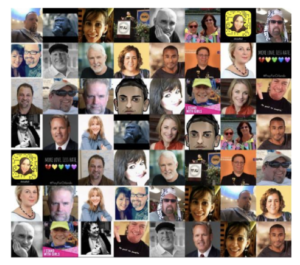I love my Facebook group – it’s a group of enthusiastic, inquisitive professionals who are a constant source of interesting conversation. Everyone’s supportive of each other and willing to share new ideas that they’re working on and reach out for help when they need it.
You might be hearing non-stop about the marketing potential of Instagram, Snapchat and the like, but there are still millions of active Facebook users. Just because it’s not the most hip, trendy tool on the market and your Mom probably has it – it’s still super effective and can help you to reach more users.
Rome wasn’t built in a day and it takes time and effort to foster a creative hub and hive of activity.
And I’m going to show you how:
Personally invite the first 100 people
Working on your outreach efforts is a good way to get people to join your group. Reach out and personally invite the first 100 people and give them the chance to be part of something really collaborative and supportive.
(Bonus tip: Use an email finder tool like ContactOut to avoid the hassle of manually searching through websites or contact lists to find the email addresses you need in order to invite them.)

Look for characters that you see engaging a lot on social media and in other groups. Invite people that have strong follower bases and are likely to invite others to join too. There’s no point inviting people who aren’t keen on engaging in groups like yours, otherwise, you’ll have a big group but zero conversation.
A good way to get influential people to join is to start sharing their content before inviting them, so you can build up a rapport. Share influencers’ posts and tag them so you can encourage them to join your group and share insight.
Focus on your group as a branding tool and invite the best people you can to become ambassadors for your brand. Thinking of a Facebook group with a sole direct marketing mindset won’t give you the results you’re looking for.
This is a long game.
Create and follow through on a consistent sharing plane
Once you’ve got members on board, they’re likely to invite others to the group. This is where you need to buckle down and concentrate on keeping your group active and creating and sharing useful content. If people aren’t gaining value, they won’t engage and might unfollow.
You can use your group to create backlinks and push people towards your site where you host your content. This will get more traction for your posts and it adds more personalized context, as people will now know you more through the group.
But don’t just share links to your blog posts. Create exclusive, valuable native content that you only host in the group. You’re keeping content and engagement in the group but you’re showing that you’re more concerned with providing your group with value and getting them involved. You can also create gated content to encourage people to join the group and promote in on organic channels.
Ask your members to share their own content, so everyone can feedback and learn something from each other.
But crucially, try and keep your group a spam-free zone…nope, no spam in here! Write some group rules and try your best to apply them and encourage others to flag spam when they see it.
Onboard moderators to share in the success
Inviting active participants of the group to become moderators is a great way to get them excited about the group, share some responsibility, and share their successes too. You can get together on a Slack chat and throw around some new ideas around for growing the group and how you can build engagement.
Your moderators can become your best ambassadors and use their personal reach to grow the group and they can also help you to enforce the rules you have. You need to invest in your group if you want to prevent spam.
Enticing influences into the group with the promise of becoming a trusted moderator that lead and facilitate discussions can be a really effective offer.
Use live video features to engage the audience
Creating great content can be done in loads of ways. You can use polls, images, and statuses to drive engagement and discussion. It allows you to get feedback from the group and shape your content marketing strategy
Native video content
work really well in Facebook groups. Up until now, you might have only engaged with the group through text, but doing regular live videos can help to boost in engagement and brand loyalty. You can answer questions, talk about topics the group’s been discussing and interview special guests and create valuable, exclusive content for your group.
The Facebook Live feature makes it really easy to integrate this with your Facebook group. Using it shows you’re committed to going above and beyond for the group, that you’re interested in interacting with members and it gives them the chance to see and learn from you in a different format.
Drive more group signups through word-of-mouth and FB ads
Obviously, you need to be promoting your group on all of your other social channels – Twitter and LinkedIn are especially good communities for driving traffic to your group
Promote your group on your own website by making sure you’ve got a link to your Facebook group and include it in your blog posts too. It should give you a steady amount of click-throughs. If you write guest posts for other sites then you should scatter some CTAs that lead to the group too. And you can also cross-promote with other groups by encouraging your own group to join another relevant group and vice versa.
Set up competitions in your group for people to invite the newest members to the group too and do giveaways for reaching certain milestones.
Facebook Ads are very effective for driving traffic to your group. Write a Facebook post and link to your group, you can then create an ad, boost your posts and select the post with your group link in. You can target a remarketing list you might have already or people who like similar groups and interests. The bigger your budget, the more people you’re going to be reaching, but it doesn’t necessarily mean people will join your group. Work on creating engaging Facebook ads that are persuasive.
Final Thoughts
Building a budding Facebook group is no walk in the park. It takes heaps of commitment and effort to make it a valuable source of information and collaboration. Don’t think of it predominantly as a sales tool, think of it as a brand awareness tool.
Work on creating consistently great content on a frequent basis and use your moderators to help you do this. Keep your group spam-free, friendly, and supportive.
A Facebook Group can be a rich source of community-based engagement and an active, engaged group is usually a happy group.





